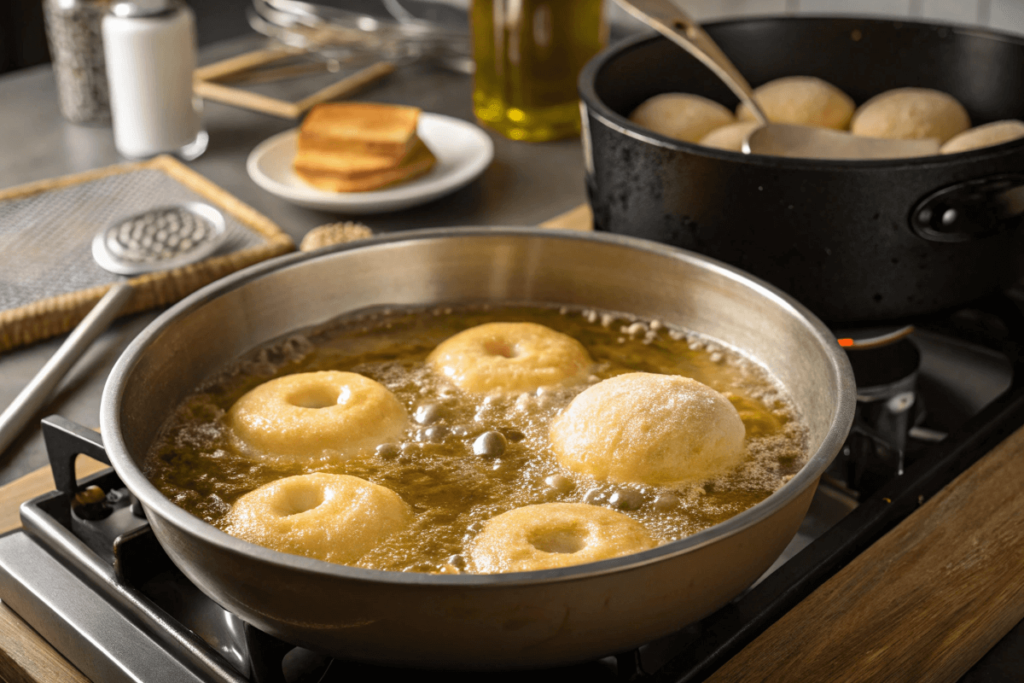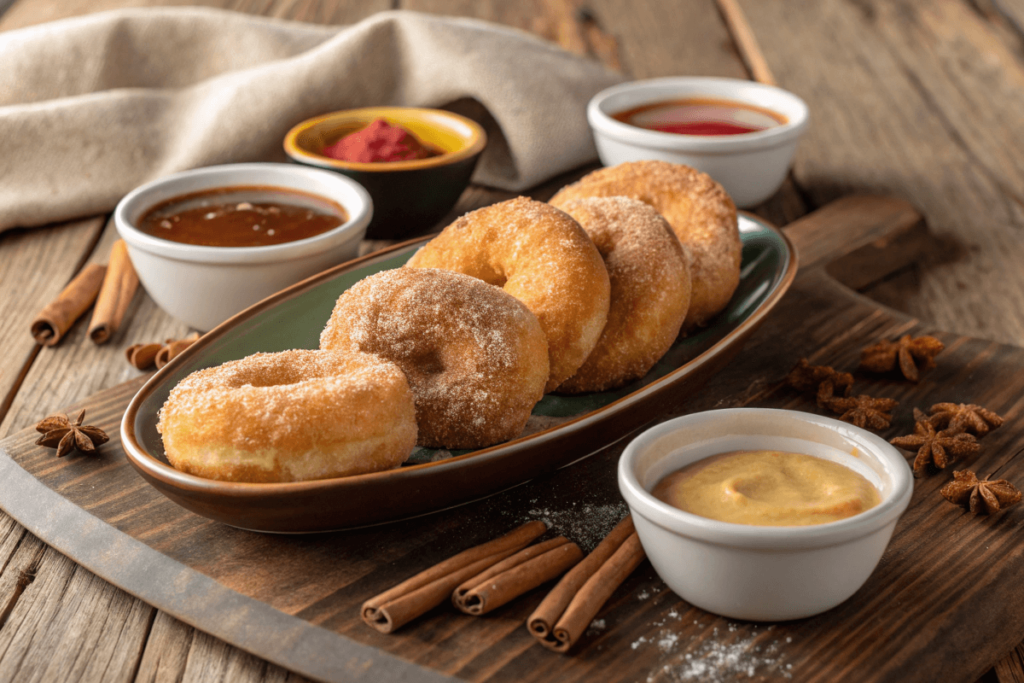Table of Contents
How to Keep Fried Dough Crispy
How do you keep fried dough crispy? It’s a question every home cook has asked after watching their golden, crunchy dough turn limp minutes after frying. Whether you’re making sweet carnival-style treats or savory fried snacks, keeping that irresistible crunch intact can feel like a mystery. In this guide, you’ll learn the essential tips and techniques—from ingredient prep to frying and reheating—that ensure your fried dough stays crispy and delicious every time.
Understanding the Science of How to Keep Fried Dough Crispy
What Makes Fried Food Crispy?
When you fry dough, the heat causes water in the batter to evaporate, creating a dry, crunchy crust. This crust forms due to the Maillard reaction, where proteins and sugars in the dough undergo a chemical transformation at high temperatures. It’s the secret behind the irresistible golden brown crunch that makes fried food so satisfying.
Factors That Lead to Sogginess
While fried dough can come out crispy, it doesn’t take much to lose that crunch. Soggy fried food is often the result of excess moisture. This moisture can come from poorly drained dough, steam trapped in storage, or even frying at too low a temperature. Using the wrong type of oil or overloading the fryer also contributes to sogginess, as it lowers the oil’s temperature, preventing the crust from forming properly.
Understanding these factors is the first step in perfecting your frying game. In the next sections, we’ll delve into pre-frying preparations, frying techniques, and storage solutions to help you maintain that perfect crispiness.
Pre-frying Preparations to Maintain Crispy Fried Dough
Choosing the Right Ingredients
To achieve crispy fried dough, start with high-quality ingredients. Opt for flour with a moderate protein content to balance tenderness and crunch. Adding a pinch of cornstarch to the dough can enhance crispiness by reducing gluten formation. Additionally, use baking powder to create light, airy dough with a crisp outer layer.
Using the Correct Batter or Dough
Your batter or dough consistency plays a vital role. A thick, even coating of batter helps form a stable crust, while an overly thin batter may cause the dough to absorb excess oil, leading to sogginess. If you’re making yeast-based dough, ensure it rises adequately for a fluffier inside and crispy outside.
Preparing the Frying Oil
Properly heated oil is crucial for achieving that golden, crunchy crust. Choose oils with high smoke points, such as peanut or vegetable oil, to withstand high temperatures without breaking down. To ensure consistency, use a deep-fry thermometer to maintain the oil temperature around 350–375°F (175–190°C). Consistent temperature prevents the dough from absorbing too much oil, which keeps it crispy.
For additional tips, consider reading Best Oil for Fried Dough.
Frying Techniques for How to Keep Fried Dough Crispy
Optimal Frying Temperature

Maintaining the right frying temperature is key to keeping fried dough crispy. If the oil’s too cool, the dough will absorb more oil and become greasy. Conversely, overheating the oil can lead to an overly dark, bitter crust. Aim for a steady frying temperature between 350°F and 375°F, adjusting as needed to maintain crisp results.
Using a Thermometer for Accuracy
Relying on visual cues alone can be risky when frying. A digital or clip-on thermometer ensures precise temperature control. It’s the best way to prevent undercooked or overly greasy dough, keeping your fried treats light and crunchy.
Batch Frying to Avoid Overcrowding
Frying too many pieces at once can drop the oil temperature, resulting in soggy dough. Instead, fry in small batches to maintain optimal heat. This also ensures even cooking and prevents pieces from sticking together, helping retain their crisp texture.
If you’re still asking yourself how do you keep fried dough crispy, these frying techniques are the key to achieving that perfectly crunchy bite every time.
If you’re still asking yourself how do you keep fried dough crispy, these frying techniques are the key to achieving that perfectly crunchy bite every time.
For related tips on frying, explore What Are the Ingredients for Fried Dough?.
Post-frying Practices to Retain Crunch
Draining Excess Oil Effectively
Right after frying, draining excess oil is crucial to maintaining crispy fried dough. Place the dough on a wire rack rather than directly on paper towels. While paper towels absorb oil, they can also trap steam, causing the dough to lose its crunch. A wire rack allows airflow underneath, preventing sogginess.
Cooling on a Wire Rack vs. Paper Towels
Why is a wire rack superior? Paper towels, though commonly used, create a moist environment by trapping heat and oil. A wire rack eliminates this issue by providing an elevated surface for air to circulate freely around the dough. This small adjustment can make a significant difference in keeping fried dough crispy.
Avoiding Steam Buildup
Once your fried dough is perfectly crisp, avoid stacking the pieces. Stacking traps heat and steam, softening that coveted crunchy texture. Instead, lay the pieces in a single layer, ensuring each retains its crispiness.
For additional insights, check out our guide on Is Fried Dough the Same as Funnel Cake?.
Storage Tips for Long-lasting Crispiness
Storing Fried Dough Properly
Storing fried dough correctly can help retain its crunch. Allow the dough to cool completely before storing it in an airtight container lined with paper towels. This absorbs residual oil and prevents the dough from becoming soggy. For short-term storage, leave the container partially open to maintain a dry environment.
Reheating Techniques Without Losing Texture
Reheating can be tricky, but it’s possible to revive the crispy texture. The best method is to reheat fried dough in an oven at 375°F for 5–7 minutes. Avoid microwaving, as it introduces moisture that softens the crust. Using an air fryer is another excellent option for bringing back the crunch quickly.
For more storage tips, explore How to Store Pumpkin Bread So It Doesn’t Get Soggy.
FAQs About Keeping Fried Dough Crispy
Why Does Fried Dough Get Soggy Quickly?
Fried dough gets soggy when it retains too much moisture or oil. Improper draining and cooling, as well as storing in airtight containers before the dough has fully cooled, can trap steam, softening the crispy exterior. Frying at too low a temperature is another culprit, as it allows oil to seep into the dough. To keep fried dough crispy, drain it well and cool it on a wire rack.
Can You Make Fried Dough in Advance?
Yes, but it requires proper handling to maintain crispiness. If you plan to prepare fried dough ahead of time, fry it until just golden, let it cool, and store it in a cool, dry place. When ready to serve, reheat the dough in an oven or air fryer to restore its crunch.
What’s the Best Way to Reheat Fried Dough?
The best way to reheat fried dough is in an oven at 375°F for 5–7 minutes. This method restores the crispy texture without making the dough greasy. Avoid microwaving, as it produces steam, softening the crust. An air fryer is another great option for quick reheating while keeping the dough crispy.
Does Freezing Affect Crispiness?
Freezing can preserve fried dough, but it often compromises crispiness. To minimize this, wrap the cooled dough in parchment paper before sealing it in a freezer-safe bag. When reheating, use an oven or air fryer to help bring back the crunch.
Final Tips for Perfectly Crispy Fried Dough
Achieving and maintaining crispy fried dough is all about paying attention to the details. From using the right ingredients and frying at the optimal temperature to proper cooling and storage, every step matters.
If you’re still wondering how do you keep fried dough crispy, remember to avoid overcrowding during frying and always drain on a wire rack. For long-term storage, ensure the dough cools completely before packing it away. Reheating methods like using an oven or air fryer are your best bets for reviving that fresh-from-the-fryer crunch.
By following these simple yet effective tips, your fried dough will stay deliciously crispy, whether you’re serving it immediately or saving it for later. Happy frying!
Common Mistakes to Avoid When Frying Dough
Using the Wrong Oil
The type of oil you use plays a huge role in keeping fried dough crispy. Oils with low smoke points, like olive oil, break down at high temperatures, leading to soggy results. Instead, choose oils like vegetable, peanut, or canola oil, which stay stable under high heat.
Frying at Inconsistent Temperatures
Maintaining a consistent frying temperature is critical. If the oil is too cool, the dough absorbs too much oil, resulting in a greasy, soft crust. Conversely, if the oil is too hot, the dough can burn on the outside while remaining undercooked inside. Use a thermometer to keep the oil between 350°F and 375°F for the best results.
Skipping Proper Cooling Techniques
Improper cooling is a common pitfall. Placing fried dough on a solid surface like a plate traps steam, softening the crust. To avoid this, always cool your dough on a wire rack to allow air circulation, keeping it crisp.
If you’ve ever wondered how do you keep fried dough crispy, avoiding these common mistakes is a great starting point for consistently crispy treats.
Experimenting with Flavors While Keeping Dough Crispy
Adding Flavorful Ingredients to the Dough
Incorporating spices, herbs, or even grated cheese into the dough can elevate your fried treats without sacrificing crispiness. For instance, adding cinnamon or nutmeg to the dough creates a sweet, aromatic twist, while garlic powder or dried rosemary adds a savory touch. These additions won’t interfere with the crispy texture if done in moderation.

Toppings That Complement Crispiness
Toppings can add flavor and visual appeal, but some can compromise the crunch. Dust your fried dough with powdered sugar or cinnamon sugar for a sweet option that won’t affect the texture. For savory lovers, a light sprinkle of parmesan or a drizzle of garlic butter enhances flavor without making the dough soggy.
Balancing bold flavors with a crispy texture is key to perfect fried dough. Whether sweet or savory, experimenting with ingredients lets you customize your treats while ensuring they stay crunchy.

